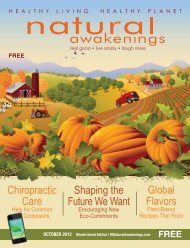STRAIGHTEN UP - Natural Awakenings
STRAIGHTEN UP - Natural Awakenings
STRAIGHTEN UP - Natural Awakenings
Create successful ePaper yourself
Turn your PDF publications into a flip-book with our unique Google optimized e-Paper software.
Ways to Lighten<br />
Your Water Footprint<br />
Eat less meat. A study published<br />
in Agricultural Water Management<br />
shows that if all U.S. residents reduced<br />
their consumption of animal<br />
products by half, the nation’s total<br />
dietary water requirement in 2025<br />
would drop by 261 billion cubic<br />
meters per year, a savings equal to<br />
14 times the annual flow of the<br />
Colorado River.<br />
Ditch bottled water. Per the U.S.<br />
Government Accountability Office,<br />
putting water in plastic bottles and<br />
shipping it just 125 miles uses 1,100<br />
times more energy than producing<br />
tap water. The Pacific Institute calculates<br />
that it takes three liters of water<br />
to produce one liter of bottled water.<br />
Create eco-friendly landscapes.<br />
Statistics published in Environmental<br />
Management confirm that turf grass<br />
currently covers some 40.5 million<br />
acres in the United States—triple the<br />
space taken up by any single U.S.<br />
irrigated farm crop. Converting thirsty<br />
lawns into native, drought-tolerant<br />
landscaping significantly drops<br />
household water use.<br />
Be water-wise at home. Visit the<br />
United States Environmental Protection<br />
Agency’s online WaterSense<br />
page at tinyurl.com/3wqbz2p to<br />
learn simple ways to save water,<br />
energy and money.<br />
Calculate personal water use at<br />
National Geographic’s tinyurl.<br />
com/274jo6v or H2OConserve.org.<br />
businesses out of<br />
harm’s way, revitalizing<br />
wetlands and<br />
marshlands and<br />
constructing levees<br />
and bypass channels in strategic locations.<br />
Napa residents will benefit from<br />
increased flood protection and reduced<br />
flood insurance rates, plus new parks<br />
and trails for recreation, higher tourism<br />
revenues and improved habitats for fish<br />
and wildlife.<br />
Communities prone to excessive<br />
storm water runoff can turn existing structures<br />
into water catchments. Portland,<br />
Oregon, is investing in “green roofs” and<br />
“green streets” to prevent sewers from<br />
overflowing into the Willamette River.<br />
Chicago now boasts more than 200 green<br />
roofs—including atop City Hall—that<br />
collectively cover 2.5 million square feet,<br />
more than any other U.S. city. The vegetated<br />
roofs are providing space for urban<br />
gardens and helping to catch storm water<br />
and cool the urban environment. Parking<br />
lots, too, can be harnessed.<br />
Many communities are revitalizing<br />
their rivers by tearing down dams that<br />
are no longer safe or serving a useful<br />
purpose, thus opening up habitats for<br />
fisheries, restoring healthier water flows<br />
and improving aquatic quality. In the<br />
10 years since the Edwards Dam was<br />
removed from the Kennebec River, near<br />
Augusta, Maine, populations of alewives<br />
and striped bass have returned in<br />
astounding numbers, reviving a recreational<br />
fishery that adds $65 million<br />
annually to the local economy.<br />
Watershed Moments<br />
Conservation remains the least expensive<br />
and most environmentally sound<br />
way of balancing water budgets. From<br />
Boston to San Antonio to Los Angeles,<br />
water consumption has decreased via<br />
relatively simple measures like repairing<br />
leaks in distribution systems; retrofitting<br />
32 Chicago North & North Shore www.NAChicagoNorth.com<br />
Water managers in 36 states<br />
expect shortages by 2013.<br />
Source: The Wall Street Journal<br />
homes and businesses<br />
with waterefficient<br />
fixtures<br />
and appliances; and<br />
promoting more<br />
sensible and efficient outdoor water use.<br />
But the potential for conservation<br />
has barely been tapped. It is especially<br />
crucial in agriculture, because irrigation<br />
accounts for 70 percent of water use<br />
worldwide, and even more in the western<br />
United States. Getting more crop per<br />
drop is central to meeting future food<br />
needs sustainably. California farmers<br />
are turning to drip irrigation, which<br />
delivers water at low volumes directly<br />
to the roots of crops. According to U.S.<br />
Department of Agriculture figures, between<br />
2003 and 2008, California’s drip<br />
and micro-sprinkler area expanded by<br />
630,000 acres, to a total of 2.3 million<br />
acres—62 percent of the nation’s total<br />
drip irrigation.<br />
Community-based education and<br />
rebates to encourage water-thrifty landscapes<br />
can help. Las Vegas, for example,<br />
pays residents up to $1.50 for each<br />
square foot of grass they rip out, which<br />
has helped shrink the city’s turf area by<br />
125 million square feet and lower its<br />
annual water use by 7 billion gallons.<br />
The water crisis requires us to pay<br />
attention to how we value and use<br />
water. Across the country, it’s essential<br />
that communities work to take care of<br />
the ecosystems that supply and cleanse<br />
water, to live within their water means<br />
and to share water equitably.<br />
Sandra Postel is director of the Global<br />
Water Policy Project, a fellow of the Post<br />
Carbon Institute and a Freshwater Fellow<br />
of the National Geographic Society. She<br />
adapted this article, based on her chapter,<br />
“Water – Adapting to a New Normal,” in<br />
The Post Carbon Reader: Managing the<br />
21st Century’s Sustainability Crises, edited<br />
by Richard Heinberg and Daniel Lerch,<br />
and a piece published in Yes! (YesMaga<br />
zine.org). For more information, visit<br />
GlobalWaterPolicy.org and National<br />
Geographic.com/freshwater.





